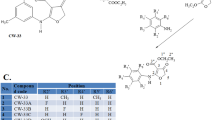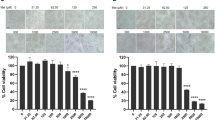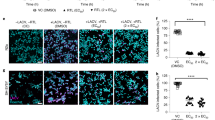Abstract
Japanese encephalitis virus (JEV) is a major pathogen that can cause acute viral encephalitis in both humans and animals. Domain III of the viral envelope protein (EDIII) is involved in binding to host cell receptor(s) to facilitate virus entry. Our previous study showed that the loop3 peptide of EDIII possesses antiviral activity against JEV infection. In this paper, we demonstrate that three residues (NSK) in loop3 are responsible for the antiviral activity of loop3 peptide. In vitro experiments showed that the tripeptide NSK could inhibit JEV infection in both BHK-21 and Neuro-2A cells by inhibiting attachment of JEV to the cells, with IC50 values of 8 μM and 6.5 μM, respectively. In vivo experiments showed that the tripeptide could increase the survival of mice challenged with JEV to 75 % when administrated intracerebrally. Therefore, this tripeptide may serve as the basis for the development of novel antiviral agents against Japanese encephalitis virus infection.






Similar content being viewed by others
References
Solomon T (2003) Exotic and emerging viral encephalitides. Curr Opin Neurol 16:411
Solomon T, Dung NM, Kneen R, Gainsborough M, Vaughn DW, Khanh VT (2000) Japanese encephalitis. J Neurol Neurosurg Psychiatr 68:405–415
Hanna JN, Ritchie SA, Phillips DA, Shield J, Bailey MC, Mackenzie JS, Poidinger M, McCall BJ, Mills PJ (1996) An outbreak of Japanese encephalitis in the Torres Strait, Australia, 1995. Med J Aust 165:256–260
Lindenbach BD, Rice C (2001) Flaviviridae: the viruses and their replication. Fields Virol 1:991–1041
Mackenzie JS, Gubler DJ, Petersen LR (2004) Emerging flaviviruses: the spread and resurgence of Japanese encephalitis, West Nile and dengue viruses. Nat Med 10:S98–S109
Tiwari S, Singh RK, Tiwari R, Dhole TN (2012) Japanese encephalitis: a review of the Indian perspective. Braz J Infect Dis 16:564–573
Rice CM, Lenches EM, Eddy SR, Shin SJ, Sheets RL, Strauss JH (1985) Nucleotide sequence of yellow fever virus: implications for flavivirus gene expression and evolution. Science 229:726–733
Zhang Y, Zhang W, Ogata S, Clements D, Strauss JH, Baker TS, Kuhn RJ, Rossmann MG (2004) Conformational changes of the flavivirus E glycoprotein. Structure 12:1607–1618
Heinz FX, Allison SL (2001) The machinery for flavivirus fusion with host cell membranes. Curr Opin Microbiol 4:450–455
McMinn PC (1997) The molecular basis of virulence of the encephalitogenic flaviviruses. J Gen Virol 78:2711–2722
Perera R, Khaliq M, Kuhn RJ (2008) Closing the door on flaviviruses: entry as a target for antiviral drug design. Antivir Res 80:11–22
Bressanelli S, Stiasny K, Allison SL, Stura EA, Duquerroy S, Lescar J, Heinz FX, Rey FA (2004) Structure of a flavivirus envelope glycoprotein in its low-pH-induced membrane fusion conformation. EMBO J 23:728–738
Kanai R, Kar K, Anthony K, Gould LH, Ledizet M, Fikrig E, Marasco WA, Koski RA, Modis Y (2006) Crystal structure of West Nile virus envelope glycoprotein reveals viral surface epitopes. J Virol 80:11000
Luca VC, AbiMansour J, Nelson CA, Fremont DH (2012) Crystal structure of the Japanese encephalitis virus envelope protein. J Virol 86:2337–2346
Modis Y, Ogata S, Clements D, Harrison SC (2004) Structure of the dengue virus envelope protein after membrane fusion. Nature 427:313–319
Nayak V, Dessau M, Kucera K, Anthony K, Ledizet M, Modis Y (2009) Crystal structure of dengue virus type 1 envelope protein in the post fusion conformation and its implications for membrane fusion. J Virol 83:4338
Chin J, Chu J, Ng M (2007) The envelope glycoprotein domain III of dengue virus serotypes 1 and 2 inhibit virus entry. Microbes Infect 9:1–6
Chiu MW, Yang YL (2003) Blocking the dengue virus 2 infections on BHK-21 cells with purified recombinant dengue virus 2 E protein expressed in Escherichia coli. Biochem Biophys Res Commun 309:672–678
Chu J, Rajamanonmani R, Li J, Bhuvanakantham R, Lescar J, Ng ML (2005) Inhibition of West Nile virus entry by using a recombinant domain III from the envelope glycoprotein. J Gen Virol 86:405
Smit JM, Moesker B, Rodenhuis-Zybert I, Wilschut J (2011) Flavivirus cell entry and membrane fusion. Viruses 3:160–171
Rey FA, Heinz FX, Mandl C, Kunz C, Harrison SC (1995) The envelope glycoprotein from tick-borne encephalitis virus at 2 A resolution. Nature 375:291–298
Takahashi H, Pool V, Tsai TF, Chen RT (2000) Adverse events after Japanese encephalitis vaccination: review of post-marketing surveillance data from Japan and the United States. Vaccine 18:2963–2969
Ohtaki E, Murakami Y, Komori H, Yamashita Y, Matsuishi T (1992) Acute disseminated encephalomyelitis after Japanese B encephalitis vaccination. Pediatr Neurol 8:137–139
Chávez JH, Silva JR, Amarilla AA, Moraes Figueiredo LT (2010) Domain III peptides from flavivirus envelope protein are useful antigens for serologic diagnosis and targets for immunization. Biologicals 38:613–618
Li C, Zhang L, Sun M, Li P, Huang L, Wei J, Yao Y, Isahg H, Chen P, Mao X (2012) Inhibition of Japanese encephalitis virus entry into the cells by the envelope glycoprotein domain III (EDIII) and the loop3 peptide derived from EDIII. Antivir Res 94:179–183
Ishag HZ, Li C, Huang L, Sun MX, Wang F, Ni B, Malik T, Chen PY, Mao X (2013) Griffithsin inhibits Japanese encephalitis virus infection in vitro and in vivo. Arch Virol 158:349–358
Sebastian L, Desai A, Madhusudana SN, Ravi V (2009) Pentoxifylline inhibits replication of Japanese encephalitis virus: a comparative study with ribavirin. Int J Antimicrob Ag 33:168–173
Sebastian L, Desai A, Shampur MN, Perumal Y, Sriram D, Vasanthapuram R (2008) N-methylisatin-beta-thiosemicarbazone derivative (SCH 16) is an inhibitor of Japanese encephalitis virus infection in vitro and in vivo. Virol J 5:64
Jones JC, Turpin EA, Bultmann H, Brandt CR, Schultz-Cherry S (2006) Inhibition of influenza virus infection by a novel antiviral peptide that targets viral attachment to cells. J Virol 80:11960
Ishag HZ, Li C, Huang L, Sun MX, Ni B, Guo CX, Mao X (2013) Inhibition of Japanese encephalitis virus infection in vitro and in vivo by pokeweed antiviral protein. Virus Res 171:89–96
Johnson RT, Burke DS, Elwell M, Leake CJ, Nisalak A, Hoke CH, Lorsomrudee W (1985) Japanese encephalitis: immunocytochemical studies of viral antigen and inflammatory cells in fatal cases. Ann Neurol 18:567–573
Raung SL, Chen SY, Liao SL, Chen JH, Chen CJ (2007) Japanese encephalitis virus infection stimulates Src tyrosine kinase in neuron/glia. Neurosci Lett 419:263–268
Ni H, Barrett ADT (1998) Attenuation of Japanese encephalitis virus by selection of its mouse brain membrane receptor preparation escape variants. Virology 241:30–36
Pessi A, Langella A, Capito E, Ghezzi S, Vicenzi E, Poli G, Ketas T, Mathieu C, Cortese R, Horvat B, Moscona A, Porotto M (2012) A general strategy to endow natural fusion-protein-derived peptides with potent antiviral activity. PLoS One 7:e36833
Larena M, Regner M, Lee E, Lobigs M (2011) Pivotal role of antibody and subsidiary contribution of CD8+ T cells to recovery from infection in a murine model of Japanese encephalitis. J Virol 85:5446–5455
Deas TS, Binduga-Gajewska I, Tilgner M, Ren P, Stein DA, Moulton HM, Iversen PL, Kauffman EB, Kramer LD, Shi PY (2005) Inhibition of flavivirus infections by antisense oligomers specifically suppressing viral translation and RNA replication. J Virol 79:4599
Holden KL, Stein DA, Pierson TC, Ahmed AA, Clyde K, Iversen PL, Harris E (2006) Inhibition of dengue virus translation and RNA synthesis by a morpholino oligomer targeted to the top of the terminal 3′ stem–loop structure. Virology 344:439–452
Noueiry AO, Olivo PD, Slomczynska U, Zhou Y, Buscher B, Geiss B, Engle M, Roth RM, Chung KM, Samuel M (2007) Identification of novel small-molecule inhibitors of West Nile virus infection. J Virol 81:11992–12004
Lim PO, Lee TH, Chung KM (2012) Potential therapeutics against flaviviruses. J Bacteriol Virol 42:108–120
Bai F, Town T, Pradhan D, Cox J, Ledizet M, Anderson JF, Flavell RA, Krueger JK, Koski RA, Fikrig E (2007) Antiviral peptides targeting the West Nile virus envelope protein. J Virol 81:2047
Hrobowski YM, Garry RF, Michael SF (2005) Peptide inhibitors of dengue virus and West Nile virus infectivity. Virol J 2:49
Löhr K, Knox JE, Phong WY, Ma NL, Yin Z, Sampath A, Patel SJ, Wang WL, Chan WL, Rao K (2007) Yellow fever virus NS3 protease: peptide-inhibition studies. J Gen Virol 88:2223
Schmidt AG, Yang PL, Harrison SC (2010) Peptide inhibitors of dengue-virus entry target a late-stage fusion intermediate. PLoS Pathog 6:e1000851
Schmidt AG, Yang PL, Harrison SC (2010) Peptide inhibitors of flavivirus entry derived from the E protein stem. J Virol 84:12549–12554
Yennamalli R, Subbarao N, Kampmann T, McGeary RP, Young PR, Kobe B (2009) Identification of novel target sites and an inhibitor of the dengue virus E protein. J Comput Aid Mol Des 23:333–341
Noble CG, Chen YL, Dong H, Gu F, Lim SP, Schul W, Wang QY, Shi PY (2010) Strategies for development of dengue virus inhibitors. Antivir Res 85:450–462
Geiss BJ, Stahla H, Hannah AM, Gari HH, Keenan SM (2009) Focus on flaviviruses: current and future drug targets. Future Med Chem 1:327–344
Wang QY, Patel SJ, Vangrevelinghe E, Xu HY, Rao R, Jaber D, Schul W, Gu F, Heudi O, Ma NL (2009) A small-molecule dengue virus entry inhibitor. Antimicrob Agents Chemother 53:1823–1831
Das S, Laxminarayana SV, Chandra N, Ravi V, Desai A (2009) Heat shock protein 70 on Neuro2a cells is a putative receptor for Japanese encephalitis virus. Virology 385:47–57
Chien YJ, Chen WJ, Hsu WL, Chiou SS (2008) Bovine lactoferrin inhibits Japanese encephalitis virus by binding to heparan sulfate and receptor for low density lipoprotein. Virology 379:143–151
Das S, Ravi V, Desai A (2011) Japanese encephalitis virus interacts with vimentin to facilitate its entry into porcine kidney cell line. Virus Res 160:404–408
Zhu YZ, Cao MM, Wang WB, Wang W, Ren H, Zhao P, Qi ZT (2012) Association of heat-shock protein 70 with lipid rafts is required for Japanese encephalitis virus infection in Huh7 cells. J Gen Virol 93:61–71
Thongtan T, Wikan N, Wintachai P, Rattanarungsan C, Srisomsap C, Cheepsunthorn P, Smith DR (2012) Characterization of putative Japanese encephalitis virus receptor molecules on microglial cells. J Med Virol 84:615–623
Batra G, Raut R, Dahiya S, Kamran N, Swaminathan S, Khanna N (2010) Pichia pastoris-expressed dengue virus type 2 envelope domain III elicits virus-neutralizing antibodies. J Virol Methods 167:10–16
Nybakken GE, Oliphant T, Johnson S, Burke S, Diamond MS, Fremont DH (2005) Structural basis of West Nile virus neutralization by a therapeutic antibody. Nature 437:764–769
Alka B, Alka K, Malik YP, Vrati S (2007) Immunogenicity and protective efficacy of the E. coli-expressed domain III of Japanese encephalitis virus envelope protein in mice. Med Microbiol Immunol 196:227–231
Acknowledgements
This project was funded by the priority academic development program of Jiangsu Higher Education Institutions.
Author information
Authors and Affiliations
Corresponding authors
Rights and permissions
About this article
Cite this article
Li, C., Ge, Ll., Yu, Yl. et al. A tripeptide (NSK) inhibits Japanese encephalitis virus infection in vitro and in vivo . Arch Virol 159, 1045–1055 (2014). https://doi.org/10.1007/s00705-013-1925-y
Received:
Accepted:
Published:
Issue Date:
DOI: https://doi.org/10.1007/s00705-013-1925-y




